Can an Overflow Dyeing Machine be used for wool fabrics?
Nov 05, 2025
Hey there! As a supplier of overflow dyeing machines, I often get asked if our machines can be used for wool fabrics. Well, let's dive right into this topic and find out.
First off, let's understand what an overflow dyeing machine is. It's a nifty piece of equipment used in the textile industry for dyeing fabrics. There are different types, like the HTHP Jet Fabric Dyeing Machine, the High Temperature and High Pressure Overflow Dyeing Machine, and the Jet Overflow Dyeing Machine. These machines work by creating an overflow of the dye liquor, which helps in evenly distributing the dye across the fabric.
Now, let's talk about wool fabrics. Wool is a natural fiber that comes from sheep, goats, and other animals. It's known for its softness, warmth, and durability. But it also has some unique properties that make dyeing it a bit tricky.
One of the main challenges when dyeing wool is its sensitivity to temperature and pH levels. Wool fibers can easily shrink or felt if they're exposed to high temperatures or extreme pH values. So, when using an overflow dyeing machine for wool, we need to be really careful about controlling these factors.
Most modern overflow dyeing machines are designed to handle a wide range of fabrics, including wool. They come with advanced temperature and pH control systems that allow us to set the optimal conditions for dyeing wool. For example, we can keep the temperature relatively low, usually around 80 - 90 degrees Celsius, to prevent the wool from shrinking. And we can adjust the pH of the dye liquor to a slightly acidic level, which is ideal for wool dyeing.
Another important factor to consider is the type of dye we use. There are different types of dyes available for wool, such as acid dyes, metal - complex dyes, and reactive dyes. Acid dyes are the most commonly used for wool because they have a good affinity for the fiber and can produce bright, long - lasting colors. Our overflow dyeing machines are compatible with these types of dyes, and they can ensure a uniform distribution of the dye on the wool fabric.
In addition to temperature, pH, and dye type, the mechanical action of the overflow dyeing machine also needs to be adjusted for wool. Wool fibers are quite delicate, so we need to use a gentle circulation of the dye liquor to avoid excessive agitation, which could cause the wool to felt. Many of our machines have adjustable flow rates and circulation speeds, allowing us to customize the dyeing process according to the specific requirements of the wool fabric.


Let's take a closer look at how the different types of overflow dyeing machines I mentioned earlier can be used for wool. The HTHP Jet Fabric Dyeing Machine is great for high - volume dyeing of wool fabrics. It uses a jet of dye liquor to move the fabric through the machine, which provides a very efficient and even dyeing process. However, as I said before, we need to make sure the temperature and agitation are set correctly to protect the wool fibers.
The High Temperature and High Pressure Overflow Dyeing Machine is also suitable for wool, especially when we need to use certain types of dyes that require higher temperatures for proper fixation. But again, we have to be cautious with the temperature settings to prevent damage to the wool.
The Jet Overflow Dyeing Machine combines the features of both jet and overflow systems. It offers a good balance between efficient dyeing and gentle handling of the fabric, making it a popular choice for wool dyeing.
Now, let's talk about the advantages of using an overflow dyeing machine for wool fabrics. Firstly, it provides a more uniform dyeing result compared to some other dyeing methods. The continuous overflow of the dye liquor ensures that every part of the wool fabric comes into contact with the dye, resulting in consistent color throughout the fabric.
Secondly, it's a relatively fast process. Our machines can dye large quantities of wool fabric in a short amount of time, which is great for textile manufacturers who need to meet tight production schedules.
Thirdly, it's a more environmentally friendly option. Since the dye liquor is recycled and reused in the machine, it reduces the amount of water and dye waste, which is good for the planet.
However, there are also some potential drawbacks. As I've mentioned, the initial setup of the machine for wool dyeing can be a bit complex. It requires some knowledge and experience to get the temperature, pH, and other parameters just right. Also, if the machine is not properly maintained, it could lead to uneven dyeing or damage to the wool fabric.
In conclusion, yes, an overflow dyeing machine can definitely be used for wool fabrics. With the right settings, the appropriate dye, and a bit of care, our machines can produce high - quality, evenly dyed wool fabrics. Whether you're a small - scale textile producer or a large - scale manufacturer, our overflow dyeing machines can meet your wool dyeing needs.
If you're in the business of wool fabric production and are looking for a reliable dyeing solution, I encourage you to get in touch with us. We can provide you with more detailed information about our machines, offer technical support, and even arrange a demonstration for you. Let's work together to achieve the best results in wool fabric dyeing.
References:
- Textile Dyeing Handbook, 3rd Edition
- Wool Science and Technology Journal, various issues
